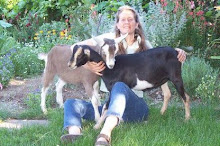
It never fails, someone will be over looking at the goats and they'll exclaim, "Wow, that goat is FAAAAAAT!!!". I then casually go into the explanation that these are dairy goats, that they are milk factories, and that to be able to produce a lot of milk, they need to be able to consume and process a large amount of feed, primarily in roughage (including hay). So that barrel they are looking at is body capacity and NOT FAT. And this usually happens in summer, so they aren't pregnant either.....
Pictured on the left see Valiant- a 3 year old in the photo- see the large barrel that I hope he passes on to his daughters (and is!), but see you can still see his bone structure- spine, hip, pin bones (under tail), but they aren't jutting out either....
How do we know that a dairy goat is proper weight? How do I know if I am feeding enough or too much? Here's a brief explanation that has worked for us for the last 10 years, allowing us to raise goats that can go the distance year after year being healthy and productive...
Hay: Ours get all they can eat within reason, and primarily alfalfa. The alfalfa discussion I'll save for another time, but suffice it to say it is VERY IMPORTANT for a dairy goat and don't let anyone talk you out of it.... Assuming the hay is clean, good quality, and no mold or dust (most 'dust' really is mold- don't feed it!), if they leave a bunch of extra in their feeders, then you are feeding too much. If on the other hand 'the plate is licked clean'- there is almost no waste or none, then you are not feeding enough- the goat/s lower on the totem pole will not be getting enough hay to sustain a healthy body or production.
Grain: feed per label directions to start with. And start them on grain slowly before they kid (see my last blog on feeding preggo does). Make any grain changes slowly- mixing some of the old brand with the new, then once a week upping it more. I usually go 1/2 and 1/2, then 3/4 new 1/4 old, then to just the new. takes 2 to 3 weeks but protects those flora hanging out in the rumen and villi in the intestine...
I have found that the alfalfa quality/quantity largely dictates the quantity of milk, and the grain largely dictates the weight of my doe. A non working doe can get fat on just alfalfa, we are not talking about buck or dry doe feeding here, just those ready to lactate or are lactating...
For weight though on any dairy goat- age, workload, or sex.....
1 to 2x a week I run a pinch test.... Stand beside your goat next to the front leg. On the outside of the goat, near where the body attaches to the leg, you will see a joint/knob facing the rear of the goat. This is their elbow. An inch or two behind that, with my thumb and forefinger, I pull the skin and tissue. On my dairy goats in summer I want at least 1/4 inch of flesh in there, up to 1/2 inch. In the winter I like 1/2 inch. If they under- I up the grain slowly, if they are over, I cut the grain a bit. As their lactation increases and decreases you'll find they need changes in the amount of grain they get. Also you'll notice individual differences and family line differences.
Also I like to run my hand along their rib cage. I should feel and slightly see the ribs in summer hair coat, but I should be able to feel a small tissue layer between my hand and the ribs. The skin should glide over the bones. If I feel any 'sharpness' to it, the goat is underweight....
Make sure in the winter months, when they are hairier, that you continue to feel. A skinny goat can easily hide under all that hair...
Don't forget routine parasite control to allow your goats to get the most out of their feed. It's expensive to feed parasites...
blessings ! Kat

